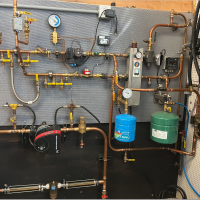Best Of
Re: Drums of water in the basement as a buffer
Most any material can capture and store heat. It will always come down to…
Is the juice worth the squeeze?
 hot_rod
hot_rod
Re: Lochinvar WB80 not lighting, many new parts already. SOLVED
you absolutely must adjust the new gas valve with a combustion analyzer or it won't fire properly or likely at all.
probably could put the old gas valve back in and set the combustion properly and be on your way.
the readings on the manometer would be the result of the house regulator and the pipe sizing. there isn't anything really useful to measure pressure wise on the outlet side of the gas valve.
it would be easy enough to test for voltage at the gas valve to see if the harness is intact.
Re: Snow melt slab insulation
That is kind of like saying "What goes into a tee must come out of a tee." Everybody already knows this, but it still needs to be said for some folks to hear it!
Re: Snow melt slab insulation
Kind of depends on how deep — if at all — the ground freezes in the winter. If the ground freezes in the winter, there will be NO heat coming up to melt the snow… at least until the ground starts thawing in the spring!
Re: Advice on a solution to leaking radiator; painting a previously painted cast iron radiator
Speaking as a consumer and not in the trades, while the solutions presented above are useful and potentially doable for a 71 year old who's handy, that rad you have truly is nothing special as another poster said. Not worth preserving. I would buy a new rad with the same EDR and put a Maid O Mist vent with the smallest size opening (I think 4 is the smallest orifice size). Once you factor in paying a moving company to transport it to the radiator refinisher, getting it repainted, removing the bad section, you might as well just get a new one. A used rad is also a possibility, but again, you're going to need to pick it up and possibly repaint, and no guarantee it doesn't have problems. It's possible, even likely, that your boiler is oversized for the existing radiation, so I would not get a smaller rad which might throw off the balance of the whole system. That rad looks like it's about 32" tall, so it's probably 3.5 sq. ft./section, 35 sq. ft. EDR total. I found a site where you can get a slenderized 4 tube, 25" tall, 18 section rad (36 EDR) for a little over $700 including shipping to Bangor in 5-8 days. The rad is about $500, shipping is under $200. The point I'm making is that a new rad may not be as expensive as you think. I would not wait too long though because my understanding is most of these are made in China, and tariffs might have an impact.
Re: Looking for advice on sizing 2 pipe baseboard
Two zones. 1.) 1st floor and 2.) 2nd floor.
Re: Looking for advice on sizing 2 pipe baseboard
Hmm. I'd be tempted to do the whole first floor in one series loop. Starting with the bathroom and ending in room 4 bedroom. Generally people want bedrooms cooler and bathrooms warmer. If bedroom 4 faces SE, even better.
Re: Looking for advice on sizing 2 pipe baseboard
Won't hurt to pipe each room separately but it will use more material and labor. At the boiler you will have to combine them in to a couple zones because you don't want any zone smaller than the minimum output of the boiler. It would let you individually balance the rooms to get the heating even.
Series loop works but to do it well you have to calculate the supply and return temp separately per room one by one on the loop and use the return temp of one room for the supply temp of the next room in the loop to size the emitters in that room.
Re: Looking for advice on sizing 2 pipe baseboard
140 supply and 120 return will give you 10,000 btu/gpm circulated.
I would use a manifold supply and return to each room
Take the heat loss for 1 room and devide it by 10,000 btu this will give you the gpm that room needs. Do this for all room.
Use 130 degree water temp as this is your average water temp (half way between supply and return temp.
Use 1 gpm water flow off their chart
with 130 average water temp the baseboard will give you 356 btu/ft from there chart with top supply and bottom return
Devide the room heat loss by 356 to get the baseboard footage. Repeat for all rooms
Size the manifold supply and return by dividing the btu on that manifold by 10000 to get gpm.
For pipe size to the manifolds (copper)
1//2"=1.5 gpm
3/4= 4gpm
1" =8gpm
1 1/4" 12gpm
Re: Monoflow Tee vs Diverter Tee
It is possible they were burning coal in that boiler when it was first installed but that has more the look of being from the era where dedicated oil and gas boilers weren't commonly available yet and it was a coal boiler installed with a conversion burner. That conversion burner is very old.
you could find the date of the patent number on the monoflo tee, it isn't older than that. My guess would be just before or just after wwii for the monoflo system and probably the boiler.

